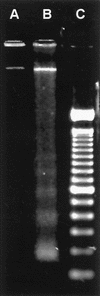Intracellular Staphylococcus aureus escapes the endosome and induces apoptosis in epithelial cells
- PMID: 9423876
- PMCID: PMC107895
- DOI: 10.1128/IAI.66.1.336-342.1998
Intracellular Staphylococcus aureus escapes the endosome and induces apoptosis in epithelial cells
Abstract
We examined the invasion of an established bovine mammary epithelial cell line (MAC-T) by a Staphylococcus aureus mastitis isolate to study the potential role of intracellular survival in the persistence of staphylococcal infections. S. aureus cells displayed dose-dependent invasion of MAC-T cells and intracellular survival. An electron microscopic examination of infected cells indicated that the bacteria induced internalization via a mechanism involving membrane pseudopod formation and then escaped into the cytoplasm following lysis of the endosomal membrane. Two hours after the internalization of S. aureus, MAC-T cells exhibited detachment from the matrix, rounding, a mottled cell membrane, and vacuolization of the cytoplasm, all of which are indicative of cells undergoing programmed cell death (apoptosis). By 18 h, the majority of the MAC-T cell population exhibited an apoptotic morphology. Other evidence for apoptosis was the generation of MAC-T cell DNA fragments differing in size by increments of approximately 180 bp and terminal deoxynucleotidyl transferase-mediated dUTP nick end labeling of the fragmented nuclear DNA of the infected host cells. These results demonstrate that after internalization S. aureus escapes the endosome and induces apoptosis in nonprofessional phagocytes.
Figures





References
-
- Almeida R A, Matthews K R, Cifrian E, Guidry A J, Oliver S P. Staphylococcus aureus invasion of bovine mammary epithelial cells. J Dairy Sci. 1996;79:1021–1026. - PubMed
-
- Bielecki J, Youngman P, Connelly P, Portnoy D A. Bacillus subtilis expressing a haemolysin gene from Listeria monocytogenes can grow in mammalian cells. Nature (London) 1990;345:175–176. - PubMed
-
- Blosser T. Economic losses from and the national research program on mastitis in the United States. J Dairy Sci. 1979;62:119–127. - PubMed
-
- Bohach G, Dinges M M, Mitchell D T, Ohlendorf D H, Schlievert P M. Exotoxins. In: Crossley K B, Archer G L, editors. The Staphylococci in human disease. New York, N.Y: Churchill Livingstone; 1997. pp. 83–111.
Publication types
MeSH terms
Substances
Grants and funding
LinkOut - more resources
Full Text Sources
Medical

